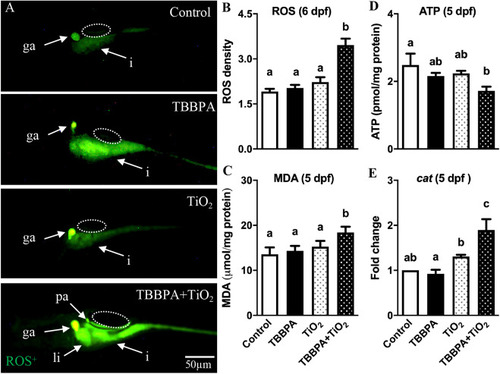Fig. 6
- ID
- ZDB-FIG-210506-17
- Publication
- Chen et al., 2021 - Developmental co-exposure of TBBPA and titanium dioxide nanoparticle induced behavioral deficits in larval zebrafish
- Other Figures
- All Figure Page
- Back to All Figure Page
|
Effect of TBBPA and TiO2 NP on oxidative stress. Zebrafish embryos were exposed to 0.1% DMSO control, 2 μM TBBPA, 0.1 mg/L TiO2 NP and TBPPA/TiO2 NP mixture from 8 to 120 hpf. Larvae harvested immediately after exposure at 5 dpf were used for MDA, ATP, and cat analysis and larvae 6 dpf were used for ROS in vivo staining. (A) Representative images showing reactive oxygen species (ROS) staining with the cell membrane-permeable ROS marker 2′,7′-di-chlorodihydrofluorescein diacetate (H2DCF-DA). (B) Quantification of ROS staining density (n = 20). (C) Lipid peroxidation expressed as malondialdehyde (MDA) by using whole larval homogenate from pooled larvae at 5 dpf (n = 6 replicates with each replicate pooled from 20 larvae). (D) Adenosine triphosphate (ATP) measured using whole larval homogenate from pooled larvae at 5dpf (n = 6 replicates with each replicate pooled from 20 larvae). (E) Gene expression fold changes of antioxidant enzyme catalase (cat) at 5 dpf (n = 3, each replicate consists pooled RNA sample from 20 larvae). The dashed elliptical area marked the swim bladder region. ga: gallbladder; pa: pancreas; i: intestine; li: liver. Values plotted are mean ± SEM and bars sharing the same letter indicate no significant difference at the level of P < 0.05 using one-way analysis of variance (ANOVA) followed by Tukey’s multiple comparison test. |

